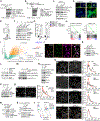Increased Serine and One-Carbon Pathway Metabolism by PKCλ/ι Deficiency Promotes Neuroendocrine Prostate Cancer
- PMID: 30827887
- PMCID: PMC6424636
- DOI: 10.1016/j.ccell.2019.01.018
Increased Serine and One-Carbon Pathway Metabolism by PKCλ/ι Deficiency Promotes Neuroendocrine Prostate Cancer
Abstract
Increasingly effective therapies targeting the androgen receptor have paradoxically promoted the incidence of neuroendocrine prostate cancer (NEPC), the most lethal subtype of castration-resistant prostate cancer (PCa), for which there is no effective therapy. Here we report that protein kinase C (PKC)λ/ι is downregulated in de novo and during therapy-induced NEPC, which results in the upregulation of serine biosynthesis through an mTORC1/ATF4-driven pathway. This metabolic reprogramming supports cell proliferation and increases intracellular S-adenosyl methionine (SAM) levels to feed epigenetic changes that favor the development of NEPC characteristics. Altogether, we have uncovered a metabolic vulnerability triggered by PKCλ/ι deficiency in NEPC, which offers potentially actionable targets to prevent therapy resistance in PCa.
Keywords: ATF4; PKClambda; aPKC; cancer metabolism; epigenetics; lineage plasticity; mTOR; neuroendocrine; prostate cancer; serine metabolism.
Copyright © 2019 Elsevier Inc. All rights reserved.
Conflict of interest statement
DECLARATION OF INTERESTS
The authors declare no competing interests.
Figures







Comment in
-
Serine and Methionine Metabolism: Vulnerabilities in Lethal Prostate Cancer.Cancer Cell. 2019 Mar 18;35(3):339-341. doi: 10.1016/j.ccell.2019.02.014. Cancer Cell. 2019. PMID: 30889375 Free PMC article.
-
Key players of neuroendocrine differentiation in prostate cancer.Ann Transl Med. 2019 Jul;7(Suppl 3):S112. doi: 10.21037/atm.2019.05.18. Ann Transl Med. 2019. PMID: 31576319 Free PMC article. No abstract available.
References
-
- Aggarwal R, Huang J, Alumkal JJ, Zhang L, Feng FY, Thomas GV, Weinstein AS, Friedl V, Zhang C, Witte ON, et al. (2018). Clinical and Genomic Characterization of Treatment-Emergent Small-Cell Neuroendocrine Prostate Cancer: A Multi-institutional Prospective Study. J Clin Oncol 36, 2492–2503. - PMC - PubMed
Publication types
MeSH terms
Substances
Grants and funding
LinkOut - more resources
Full Text Sources
Other Literature Sources
Medical
Molecular Biology Databases
Miscellaneous

